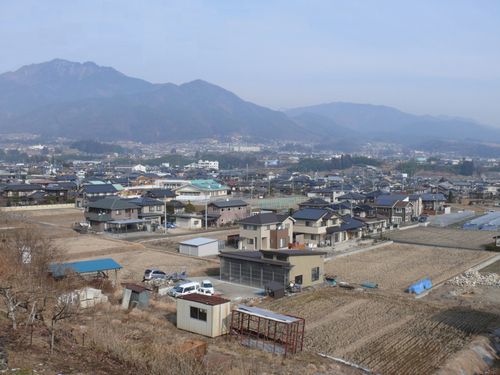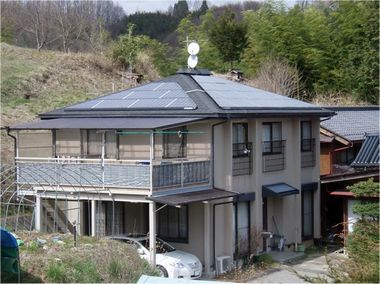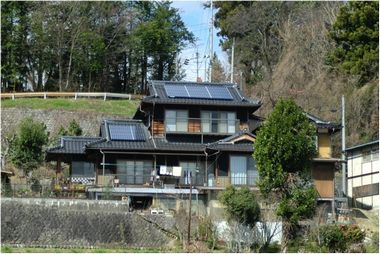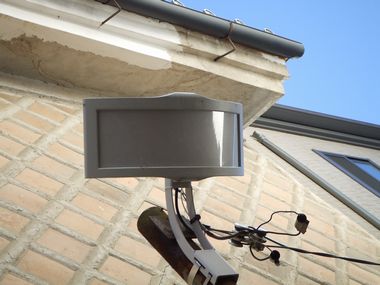February 22, 2011
Achieving Independent Local Change -- the Ohisama Zero-yen System in Iida City
Keywords: Newsletter
JFS Newsletter No.101 (January 2011)
"Initiatives and Achievements of Local Governments in Japan" (No. 33)

Copyright 2011 Ohisama Shinpo Energy Corporation All Rights Reserved.
Located in southern Nagano Prefecture in central Japan, Iida City is one of the prefecture's larger cities with the population of 100,000 people. In the Edo period (1603-1868), it was prosperous as the castle town of the Iida province. At present, it is well known for its apple-tree lined streets and traditional puppet shows, and is called the Little Kyoto of the southern Shinshu district.
One reaches Iida by the Iida line (an independent local train line) or on the Chuo Expressway; it takes several hours from Tokyo or Nagoya on the highway bus. Its geographical uniqueness has contributed to make the people of Iida independent. Their characteristic feeling that they can accomplish anything on their own has led the city to promote original initiatives in the fields of environment and culture, and these have been showing good results.
The 'Ohisama Zero-yen System'
More and more households are installing solar power generators in Japan and around the world. Many countries have been concentrating on solar power generators at large-scale commercial facilities, while Japan has been putting its efforts into residential-use generators. To reach its emission reduction target of 25 percent by 2020, Japan aims to promote the installation of solar generators by 10 million households out of a total of about 50 million.
Some measures such as a system of renewable energy payments, or a feed-in-tariff, have been implemented in which electricity generated by a household solar system is purchased at a price higher than the market price in an effort to compensate for the household's initial investment. Even so, many households are unable to purchase such systems because of their high initial cost.
Against this backdrop, the city launched a system to install solar power generators at no initial cost, the Ohisama Zero-yen System. "Ohisama" is a familiar term for the sun, and this title communicates the meaning "a solar power system for free."
The Ohisama Shinpo Energy Corporation plays a key role in planning and running this project. The company was established as part of a system involving the non-profit organization, Minami Shinshu Ohisama Shinpo, with the aim of creating a sustainable, recycling-oriented society while providing business services for energy conservation and energy supplies in close cooperation with local communities. It also provides energy service company (ESCO) business services for energy conservation, and energy-creation business services that utilize the light and heat of the sun, wood biomass utilizing forest resources, and energy created from other natural sources such as hot springs and ground water.
Then, what is the "Ohisama Zero-yen System?"
This system is promoted under the slogan, "Solar power generation on the roof of every home." First, the company installs a solar power generator at no initial cost on the roofs of ordinary households that have applied and passed a screening test. The household pays a fixed amount (19,800 yen or U.S.$244 for a 3.3 kilowatt system) for nine years. They sell the surplus electricity that is generated by the solar panels but not consumed by the household to the local power company, and after the 10th year, owership of the solar panels passes to the household without further cost.

Copyright 2011 Ohisama Shinpo Energy Corporation All Rights Reserved.
Not having to pony up the initial cost is enough to be happy about, but installations so far show that a household will end up paying a fixed rate of about 240,000 yen (about U.S.$2,963) per year for nine years but will earn somewhere between 140,000 (about U.S.$1,728) and 180,000 yen (about U.S.$2,222) per year by selling surplus electricity. As a result, the household will end up paying a net cost of from 60,000 (about U.S.$741) to 100,000 yen (about U.S.$1,235) per year for nine years, with ownership of the system being tranferred to the household in the 10th year.
This system is made possible through Ohisama Shimpo Energy's collaboration with Iida City and a local bank, the Iida Shinkin Bank. In the progam's first fiscal year of 2009, many requests for information and applications were received for an opening quota of 30 households, resulting in an application ratio of 2.1.
In the second year (2010) the number of openings was increased to 50 households. The organization is also trying to promote solar power generation with citizen funding. Investors receive dividends with a targeted yield of 2.0-2.5 percent for their investment in the scheme. More and more citizens in and out of Iida City, including those in other prefectures, have invested in this project saying "I'd like to use my little surplus money for a good cause," or "I live in a multi-family apartment building, but I'd like to support local natural energy," or "I live in city, but I'd like to help promote solar power generation."
The Japanese government selected Iida as an Eco-Model City and included the Ohisama Zero-yen System in its collection of best practices, presenting it as an advanced initiative that should be implemented nationwide. By promoting collaboration between the local government and businesses, this system adequately meets the needs of many people who want to install a solar power generation system but are unable to do so due to its high initial cost. The system also promotes energy education and conservation at home. We look forward to seeing further development and expansion of this type of system throughout Japan in the future.

Copyright 2011 Ohisama Shinpo Energy Corporation All Rights Reserved.
Security Lighting All Made in Iida
Iida City has other initiatives. One of them is its "Security Lighting - All Made in Iida" Program. In the city, there are about 6,000 security lights. By switching from conventional security lights to those with light-emitting diodes (LEDs), electricity use and CO2 emissions could be reduced to about two thirds. Therefore, Iida City examined the possibilities for switching to LED security lights as part of a climate change prevention measure, but the problem was the high price of LED security lights.
Security lights manufactured by a major company were being sold at about 60,000 yen (about U.S.$741) per unit. Iida City has many regional businesses with a range of skills, and so a project to manufacture LED security lighting in Iida City was launched.
The initiative grew out of a joint venture group that had been founded ten years ago mainly by the Iida Shimoina Local Industry Promotion Center, which involved the local government, local businesses and others. Among the members of this group, 15 companies with LED and security light technologies joined the new initiative. They were divided into two groups and each group sought to develop a different type of security lighting. This reduced development risk as they would be replacing 6,000 lighting units in the city over several years, and helped lead to success.
They launched the project in July 2009 and developed products by December of the same year. So far they have replaced 3,000 security lighting units, using a subsidy granted to Eco-Model Cities. Now they are replacing the rest of the lights in the city, having incorporated many improvements.

What was the cost? One unit cost only 19,000 yen (about U.S.$233) compared to a product from a major manufacturer at 60,000 yen (about U.S.$731). Due to continuous cost-reduction efforts, unit cost has been decreased to 18,000 yen (about U.S.$222). The project group receives many inquiries not only from within the city but from other local governments across the country as well.
At first, even the companies undertaking the project were not sure if they could succeed, but now they feel motivated, saying that "We tried and we succeeded. We want to improve the products more." A variety of companies in the city gathered to share their technologies for the project, developed the all-made-in-Iida LED security lighting units, and marketed them around the country. A local environmental initiative brought financial benefits to the local economy -- that is one definition of good practice achieving compatibility (integration) of the environment and the economy. It has also encouraged and revitalized the local community.
The city has carried out various progressive initiatives and has a history and thus a cultural foundation of this kind of independent action. In 1997, when the city formulated its fourth basic plan, it asked for citizens to take part in the process and 60 people joined upon request. Divided into four groups, they considered what should be and should not be included in the basic plan. It turned out that each group's proposal included environmental issues. Responding to this, the city adopted a vision for making itself an environmental and cultural municipality as the core of its fourth basic plan.
It was still quite progressive in 1997 for a Japanese municipality to include citizens in the process of formulating its basic plan. In Iida, however, the citizens had already taken part in formulating the third basic plan in 1988; this was much earlier than other cities and may represent the first case of its type in Japan. The city has continued to involve citizens in its policy-making process, including the establishment of the city's first environmental plan. The spirit of "the city together with citizens" is ingrained in both the city government and the citizens.
It will be very exciting to see how Iida develops its initiatives using local power in the future.
See also: IIDA CITY: "AN ENVIRONMENTAL TOWN INSPIRES OTHERS"
http://www.japanfs.org/en/mailmagazine/newsletter/pages/027934.html
Written by Junko Edahiro
Related
"JFS Newsletter"
- 'Good Companies in Japan' (Article No.4): 'Eightfold Satisfaction' Management for Everyone's Happiness
- "Nai-Mono-Wa-Nai": Ama Town's Concept of Sufficiency and Message to the World
- 'Yumekaze' Wind Turbine Project Connects Metro Consumers and Regional Producers: Seikatsu Club Consumers' Co-operative
- Shaping Japan's Energy toward 2050 Participating in the Round Table for Studying Energy Situations
- 'Good Companies in Japan' (Article No.3): Seeking Ways to Develop Societal Contribution along with Core Businesses


